Total Rebirth
Support Systems
Garments
Phases and Fashions
Decorations and Details
100
The Italian Renaissance began _____ years before the Northern European Renaissance.
What is 100?
100
The name for the padded skirt support shown here:


What is a Bum Roll?
100
The Italian term for the chemise, pictured below:

What is a Camicia?
100
The Italian region that the pictured style of dress comes from:

What is Venice or Venetian?
100
The name for the garment decoration technique pictured here:


What is Slashing/Paning?
200
The rules restricting the use of specific fabrics, garment lengths, and/or colors by certain social classes were known as ___________________
What are Sumptuary Laws?
200
The silhouette achieved through stomach padding on men pictured here:

What is the Peascod Belly?
200
The outermost "jacket" worn over the doublet, pictured here:

What is a Jerkin?
200
Identify the phase these images best resemble for both genders:




What is Phase 1 - Medieval Transition for Men and Women?
MEN'S PHASES:
1 - Medieval Transition: Similar to late Middle Ages in components. Shoes now round at the toe.
2 - German: Wide, full, puffs, slashes, and panes. Very square silhouette. Heavy use of gold chains.
3 - Spanish: Narrower shoulders, gradually wider at hip. Trunk hose now being worn. Heavy use of black. Peascod belly and ruff are common components.
WOMEN'S PHASES:
1 - Medieval Transition: Transition period that incorporates Medieval details - simpler silhouette (follows cote/surcote lines), fitted bodice, may have hanging/funnel shaped sleeves, often incorporates a veil or head covering.
2a - German: Mostly women in Germany, others in Spanish phase. Fitted bodices with low, square or rounded necklines along with softly gathered skirts. Dog Collar Necklace, horizontal bands on sleeves, and use of gold common in this phase.
2b - Spanish: Dresses were hourglass shaped, usually had high or square necklines and flared skirts. The skirt was often open in front to show the petticoat. Ruffs and hanging sleeves were common elements.
3 - Elizabethan/Cartwheel Farthingale
MEN'S PHASES:
1 - Medieval Transition: Similar to late Middle Ages in components. Shoes now round at the toe.
2 - German: Wide, full, puffs, slashes, and panes. Very square silhouette. Heavy use of gold chains.
3 - Spanish: Narrower shoulders, gradually wider at hip. Trunk hose now being worn. Heavy use of black. Peascod belly and ruff are common components.
WOMEN'S PHASES:
1 - Medieval Transition: Transition period that incorporates Medieval details - simpler silhouette (follows cote/surcote lines), fitted bodice, may have hanging/funnel shaped sleeves, often incorporates a veil or head covering.
2a - German: Mostly women in Germany, others in Spanish phase. Fitted bodices with low, square or rounded necklines along with softly gathered skirts. Dog Collar Necklace, horizontal bands on sleeves, and use of gold common in this phase.
2b - Spanish: Dresses were hourglass shaped, usually had high or square necklines and flared skirts. The skirt was often open in front to show the petticoat. Ruffs and hanging sleeves were common elements.
3 - Elizabethan/Cartwheel Farthingale
200
The name for the tighter German necklace pictured here:


What is a Dog Collar Necklace?
300
Transition from a communal mentality to _____________, an emphasis on personal development
- one of the major changes during the Renaissance
- one of the major changes during the Renaissance
What is Individualism?
300
The frame used to support the ruff (pictured here):


What is the Supportasse?
300
The name for the separate short skirts worn with a jacket or doublet that are made from a series of lined and stiffened gores (wedge-shaped pieces) pictured here:


What are Bases?
300
Identify the phase these images best resemble for both genders:




What is Spanish (Phase 3 for MEN, Phase 2b for WOMEN)?
MEN'S PHASES:
1 - Medieval Transition: Similar to late Middle Ages in components. Shoes now round at the toe.
2 - German: Wide, full, puffs, slashes, and panes. Very square silhouette. Heavy use of gold chains.
3 - Spanish: Narrower shoulders, gradually wider at hip. Trunk hose now being worn. Heavy use of black. Peascod belly and ruff are common components.
WOMEN'S PHASES:
1 - Medieval Transition: Transition period that incorporates Medieval details - simpler silhouette (follows cote/surcote lines), fitted bodice, may have hanging/funnel shaped sleeves, often incorporates a veil or head covering.
2a - German: Mostly women in Germany, others in Spanish phase. Fitted bodices with low, square or rounded necklines along with softly gathered skirts. Dog Collar Necklace, horizontal bands on sleeves, and use of gold common in this phase.
2b - Spanish: Dresses were hourglass shaped, usually had high or square necklines and flared skirts. The skirt was often open in front to show the petticoat. Ruffs and hanging sleeves were common elements.
3 - Elizabethan/Cartwheel Farthingale
MEN'S PHASES:
1 - Medieval Transition: Similar to late Middle Ages in components. Shoes now round at the toe.
2 - German: Wide, full, puffs, slashes, and panes. Very square silhouette. Heavy use of gold chains.
3 - Spanish: Narrower shoulders, gradually wider at hip. Trunk hose now being worn. Heavy use of black. Peascod belly and ruff are common components.
WOMEN'S PHASES:
1 - Medieval Transition: Transition period that incorporates Medieval details - simpler silhouette (follows cote/surcote lines), fitted bodice, may have hanging/funnel shaped sleeves, often incorporates a veil or head covering.
2a - German: Mostly women in Germany, others in Spanish phase. Fitted bodices with low, square or rounded necklines along with softly gathered skirts. Dog Collar Necklace, horizontal bands on sleeves, and use of gold common in this phase.
2b - Spanish: Dresses were hourglass shaped, usually had high or square necklines and flared skirts. The skirt was often open in front to show the petticoat. Ruffs and hanging sleeves were common elements.
3 - Elizabethan/Cartwheel Farthingale
300
The pouch of fabric found at the front of men's trunk hose that was often emphasized and decorated at this time
What is a Codpiece?
400
Martin Luther was responsible for the division of the Catholic church, known as ___________________
- one of the major changes during the Renaissance
- one of the major changes during the Renaissance
What is the Protestant Reformation?
400
The name for the wooden or whalebone insert used in the front of the stays (corset) pictured here:
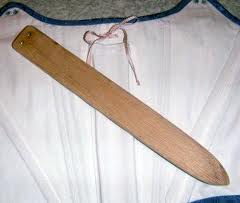

What is the Busk?
400
Very high platform-soled shoes that were worn throughout Italy and in northern Europe, especially in Venice (pictured here):


What are Chopines?
400
Identify the phase this image best resembles for both genders:
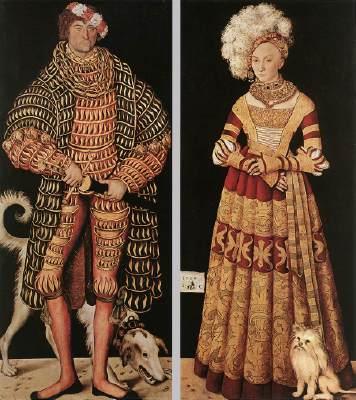

What is German - Phase 2 for MEN, Phase 2a for WOMEN?
MEN'S PHASES:
1 - Medieval Transition: Similar to late Middle Ages in components. Shoes now round at the toe.
2 - German: Wide, full, puffs, slashes, and panes. Very square silhouette. Heavy use of gold chains.
3 - Spanish: Narrower shoulders, gradually wider at hip. Trunk hose now being worn. Heavy use of black. Peascod belly and ruff are common components.
WOMEN'S PHASES:
1 - Medieval Transition: Transition period that incorporates Medieval details - simpler silhouette (follows cote/surcote lines), fitted bodice, may have hanging/funnel shaped sleeves, often incorporates a veil or head covering.
2a - German: Mostly women in Germany, others in Spanish phase. Fitted bodices with low, square or rounded necklines along with softly gathered skirts. Dog Collar Necklace, horizontal bands on sleeves, and use of gold common in this phase.
2b - Spanish: Dresses were hourglass shaped, usually had high or square necklines and flared skirts. The skirt was often open in front to show the petticoat. Ruffs and hanging sleeves were common elements.
3 - Elizabethan/Cartwheel Farthingale
MEN'S PHASES:
1 - Medieval Transition: Similar to late Middle Ages in components. Shoes now round at the toe.
2 - German: Wide, full, puffs, slashes, and panes. Very square silhouette. Heavy use of gold chains.
3 - Spanish: Narrower shoulders, gradually wider at hip. Trunk hose now being worn. Heavy use of black. Peascod belly and ruff are common components.
WOMEN'S PHASES:
1 - Medieval Transition: Transition period that incorporates Medieval details - simpler silhouette (follows cote/surcote lines), fitted bodice, may have hanging/funnel shaped sleeves, often incorporates a veil or head covering.
2a - German: Mostly women in Germany, others in Spanish phase. Fitted bodices with low, square or rounded necklines along with softly gathered skirts. Dog Collar Necklace, horizontal bands on sleeves, and use of gold common in this phase.
2b - Spanish: Dresses were hourglass shaped, usually had high or square necklines and flared skirts. The skirt was often open in front to show the petticoat. Ruffs and hanging sleeves were common elements.
3 - Elizabethan/Cartwheel Farthingale
400
The name for the heart-shaped, sheer, and cape-like veil pictured here:

What is a Conch (or Conque = French)
500
This item was the first to be created using moveable type on a printing press
- one of the many major changes during the Renaissance
- one of the many major changes during the Renaissance
What is the Gutenberg Bible?
500
The shaped petticoat pictured here:
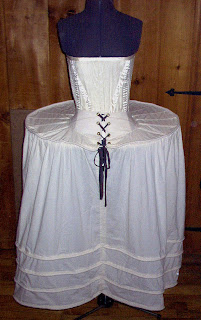

What is the Cartwheel Farthingale?
500
Square toed shoes that are very wide in the toe area (pictured here):
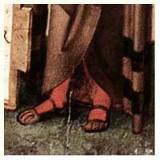

What are Duck Bill Shoes?
500
Identify the phase this image best resembles:
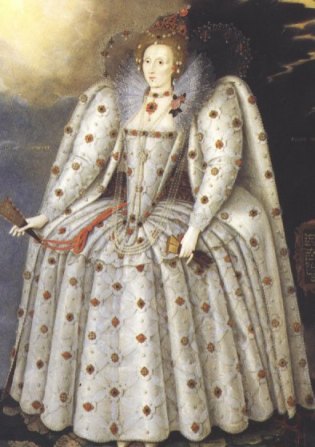

What is phase three - Elizabethan/Cartwheel Farthingale?
MEN'S PHASES:
1 - Medieval Transition: Similar to late Middle Ages in components. Shoes now round at the toe.
2 - German: Wide, full, puffs, slashes, and panes. Very square silhouette. Heavy use of gold chains.
3 - Spanish: Narrower shoulders, gradually wider at hip. Trunk hose now being worn. Heavy use of black. Peascod belly and ruff are common components.
WOMEN'S PHASES:
1 - Medieval Transition: Transition period that incorporates Medieval details - simpler silhouette (follows cote/surcote lines), fitted bodice, may have hanging/funnel shaped sleeves, often incorporates a veil or head covering.
2a - German: Mostly women in Germany, others in Spanish phase. Fitted bodices with low, square or rounded necklines along with softly gathered skirts. Dog Collar Necklace, horizontal bands on sleeves, and use of gold common in this phase.
2b - Spanish: Dresses were hourglass shaped, usually had high or square necklines and flared skirts. The skirt was often open in front to show the petticoat. Ruffs and hanging sleeves were common elements.
3 - Elizabethan/Cartwheel Farthingale
MEN'S PHASES:
1 - Medieval Transition: Similar to late Middle Ages in components. Shoes now round at the toe.
2 - German: Wide, full, puffs, slashes, and panes. Very square silhouette. Heavy use of gold chains.
3 - Spanish: Narrower shoulders, gradually wider at hip. Trunk hose now being worn. Heavy use of black. Peascod belly and ruff are common components.
WOMEN'S PHASES:
1 - Medieval Transition: Transition period that incorporates Medieval details - simpler silhouette (follows cote/surcote lines), fitted bodice, may have hanging/funnel shaped sleeves, often incorporates a veil or head covering.
2a - German: Mostly women in Germany, others in Spanish phase. Fitted bodices with low, square or rounded necklines along with softly gathered skirts. Dog Collar Necklace, horizontal bands on sleeves, and use of gold common in this phase.
2b - Spanish: Dresses were hourglass shaped, usually had high or square necklines and flared skirts. The skirt was often open in front to show the petticoat. Ruffs and hanging sleeves were common elements.
3 - Elizabethan/Cartwheel Farthingale
500
The jeweled decoration held in place by a band or chain that ornaments the center of the forehead (pictured here):


What is a Ferronière?